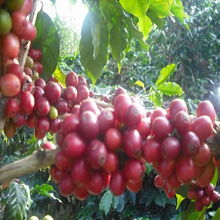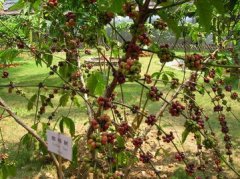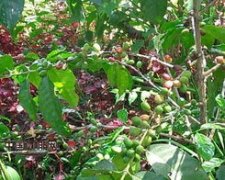A brief introduction to the Gene Mutants of Coffee species

Kenya [SL28] and [SL34](Bourbon lineage):
Bourbon descendants selected and bred in Kenya by French and British missionaries and researchers in the early 20th century. For centuries, Kenya has adapted to high concentrations of phosphoric acid soil, breeding Kenya bean special sour fragrance spirit, different from the Central and South American bourbon bean. The best Kenyan coffee comes from these two excellent strains, but when transplanted to Asia, it has lost its flavor and does not show the characteristics of Kenyan beans.
Geisha: Late bloomer variety. In 1931, it was exported to Kenya from Geisha Mountain in southwestern Ethiopia, where it traveled to Tanzania and Costa Rica. In the 1960s, it was transplanted to Panama. After nearly half a century, it was a blockbuster. It defeated the ever-winning varieties of bourbon, kadura, kaduai and tibika, and won the first prize in the Panama National Bean Cup in 2005, 2006 and 2007. In 2007, Rose won the International Famous Bean Cup competition sponsored by the American Fine Coffee Association. The bidding price was US $130 per pound, setting a record for the highest price of competitive beans in history. It is reported that the next Panama National Treasure Bean Competition will be divided into two groups: Rose Summer and Non-Rose Summer, so as not to be robbed of the glory of other varieties by Rose Summer. Guixia is a member of the Tibika family, but after leaving Ethiopia for more than 70 years, he has become famous. Moreover, Ethiopia is a treasure trove of Arabica genes. Any donation of a variety abroad is enough to make waves in the coffee market.
Bourbon Amarello: Also known as Yellow bourbon, it is a yellow skinned variety of Bourbon found in the Brazilian state of Sao Paulo. Coffee fruits usually turn red when ripe, but bourbon does not turn red when ripe, orange and so named. Huang Boben swept the Brazil [COE] competition in the past two years. Almost all the top three awards were won by Huang Boben. He became the popular fried chicken in the fine coffee industry and the formula bean of fine Espresso. The name of Arabica yellow peel variety, all crowned with "Amarello", includes yellow cadura, yellow caduai, etc.
Caturra: A single-gene variant of Bourbon discovered in Brazil in the 1950s. Both productivity and disease resistance are better than those of Bourbon, but the trees are shorter and easier to harvest. Unfortunately, like Bourbon, there is a cycle problem of fluctuation of productivity every two years. The flavor is comparable to or slightly worse than bourbon beans, more importantly, the adaptability is super strong, do not need shade trees, direct exposure to the sun can also be vibrant, commonly known as sun coffee (Sun Coffee) can adapt to high density planting, but must be more fertilizer, increase the cost, so the initial acceptance of coffee farmers is not high. But prices soared in the 1970s, and farmers switched to kadura to boost yields, which was promoted by the Brazilian and Colombia authorities with great success. Farmers 'acceptance of Kadura meant a major change in planting technology. Brazil and Colombia switched to high-yield, high-density solarization, and by 1990, 14 million bags of coffee beans could be harvested on one million hectares, an increase of 60%. No wonder the high-yield, high-quality variety Kadura has become the mainstay of all producing countries. Kadura is most suitable for planting at low altitudes of 700 meters to high altitudes of 1700 meters, and has strong altitude adaptability. However, the higher the altitude, the better the flavor and the relatively reduced production capacity, which is the fate of high-quality beans. Some scholars call Kadura a dense and exposed version of the wave, which is to the point. There is also a variant of yellow catura (Caturra Amarello) in Central and South America, but it is not as popular as yellow.
Pacas: Bourbon variety found in El Salvador. In 1935, Salvadoran coffee farmers Paccas selected high-yield San Ramon bourbon varieties for farm cultivation. In 1956, a friend discovered that the bourbon on his farm produced more fruit than the same kind of coffee tree, so he asked a professor at the University of Florida to identify it and confirmed that the bourbon had a genetic mutation. He named the new variety "Pakas" after the farm evaluation. Parkas are popular in Central America for their high yield and quality, and also act as "stallions" for improved varieties. El Salvador currently has 68 per cent Bourbon, 29 per cent Pakas and 3 per cent Kaduai, Kadura and Noble Pakamara.
Villa Sarchi: The Bourbon variety first discovered in Costa Rica in the 1960s has often appeared in competition winners in recent years, and is considered a dark horse.
Maragogype: Bean at least three times larger than the average Arabica, is the world's largest, hence the name. The elephant bean is the best-known variety of Tibica bean, first discovered in 1870 in the Maragogype bean growing region of the northeastern Brazilian state of Bahia. Fine bean farmers often call it Malagojpe, the birthplace, commonly known as elephant beans. Mexico, Guatemala, Colombia and the Dominican Republic have small amounts of cultivation. Elephant beans adapt to the low altitude of 700 to 800 meters, but the flavor is lacking, there is no characteristic, even earthy smell, it is better to choose a slightly higher altitude of more than 1000 meters, the flavor is better, the sour taste is mild, sweet and pleasant.
Although the elephant bean is large in size, it belongs to soft beans. Most people don't have a good impression of it, but in fact the higher altitude elephant bean has a special flavor, soft fragrance and charm (because the higher altitude has less fruit, more concentrated nutrients), but the productivity is very low, not enough economic benefits, plus the fruit is too large to wash or semi-wash, so farmers are not willing to plant, one after another to plant high-yield kadura or kaduai. When baking beans, due to the low density of beans, such as traditional semi-direct fire baking, it is appropriate to use low fire; if hot air baking, be sure to bake a small amount, lest the hot air can not blow the beans, can not turn and appear black focus.
Arabica intraspecific hybrid
Mundo Novo (New World): A natural hybrid of the Arabican bourbon and Sumatra tibican, first discovered in Brazil. High yield, pest resistance, cup test quality is also good, known as the new hope of Brazil coffee industry, help name the new world. Although not in the top three [COE] in Brazil, it has appeared in the top 20 lists several times. Brazil planted it extensively after 1950. The biggest disadvantage is that the trees are often more than 3 meters high and difficult to harvest.
Catuai: It is also a hybrid of Arabica, a hybrid of New World and Kadulla, which helps inherit the advantages of Kadulla's low tree body and changes the shortcomings of New World; another advantage is that the fruit is solid and does not fall off easily in case of strong wind, making up for the weakness of Arabica fruit without wind, but the overall flavor performance is monotonous than Kadulla, which is the biggest regret. Kaduai also has red fruits and yellow fruits. Statistically, red fruit kaduai wins more often. Carduai, Cardura, New World and Bourbon are the four main varieties in Brazil.
Pacamara: A very complex pedigree, it is a hybrid of the Tibica variety Elephantbean and the Bourbon variety Pacas. Bean is second only to elephant bean, is El Salvador's rising star, but also in the past two years through the global fine coffee hybrid varieties. He won the 2007 Guatemala and Honduras [COE] double championships, and even won the top three prizes in El Salvador. The name "Pacamara" is well taken, a compound of Pacas and Maragogepe. Pacamara was a fine variety produced by the Salvadoran Coffee Research Institute in 1957 and 1958. It has only recently become a favorite of fine coffee.
Kent: A hybrid of Tibica discovered in India with high yield and disease resistance, but has never won an international cup test.
Interspecific Hybrid Arabica with robust bean
Timor: A hybrid of Arabica and Robusta found in East Timor, but closer to Arabica because it has 44 chromosomes of Arabica rather than 22 of Robusta. Timmy is low in acidity and lacks character. Taiwan often uses it to make low-cost formula beans, but East Timor also has washed high-altitude pure tibica, which has entered the US boutique market. When buying Tim coffee, be sure to make sure that the product is a hybrid or a purebred Tibica washed bean. The two are of poor quality. The former is plain and the latter has the standard of fine beans.
Catimor: An important variety of commercial beans at present. East Timor was colonized by Portugal for 400 years, and the Portuguese had long been in contact with the coffee trees of East Timor. In 1959, the Portugal moved the Brazilian bourbon mutant Kadura to East Timor and interbred it with a Tim of Robusta descent. They succeeded in breeding Kadura, which was highly resistant to disease and highly productive. Between 1970 and 1990, leaf rust affected coffee producing countries worldwide. With the assistance of international organizations, catim was widely promoted in producing countries to resist leaf rust and increase production capacity. Although Victim inherited Robusta's strong disease resistance, it also inherited the gene with poor flavor. In addition, although the early Victim had a large production capacity, it needed shade trees to wait on it, otherwise it would wither easily. It could be said that it was strong on the outside and weak on the inside. Many botanists have studied the improvement of Catim varieties for decades, and dozens of new varieties have been developed. Colombia is the largest harvest country, in 1982 to cultivate solar-able Catim, and the name of the country "Colombia." Colombia claims that after many generations of cross-breeding [Colombia] and the general Kadim is different, and now Kadura has become the country's two main varieties, has long replaced the weak and sickly production of less Tibica. However, Colombia's [COE] winners are mostly Kadura, and Colombia, which has Robusta ancestry, rarely wins. Colombia exports a lot of [Supermo] commercial beans should be lower altitude [Colombia] or Kadura, rather than the traditional Tibica, this is the main reason why [Supermo] flavor is getting poorer, but Colombia can not reproduce the production of less Tibica.
In recent years, botanists around the world have returned to multi-generation cross breeding of arabica and catim in an attempt to reduce the robusta lineage and improve the elegant flavor of arabica, thus breeding new generations of catim, including [Catimor H 528],[Catimor H 306], and Costa Rica's [Catimor T 5175],[Catimor T 8667]. But Costa Rica has abandoned the cultivation of kadim in favour of the kadura variety and is exporting improved kadim to Asian producers. There are countless strains of Catim, and the cup test results and habits of each strain are also different. However, although it has been improved for many years, Catim has not yet entered the top 30 list of international cup test competitions. The biggest weakness of kadrim is that it is not inferior to kadura, kaduai, or bourbon beans grown at low altitudes, but it is significantly inferior to bourbon, kaduai, or kadura when grown at high altitudes. It remains to be seen whether Katim can rise to the level of elegance. Looking forward to one day can cultivate suitable for high-altitude super Catim, shocked the boutique coffee world.
Icatu: Masterpiece of Brazilian multi-generation hybrid improved varieties. Arabusta, a hybrid Arabica and robusta, has improved yields and resistance to leaf rust in the past, but coffee flavor has been poor. Scientists then crossed Arabica varieties such as Kadura, New World and Bourbon for multiple generations, reducing the bad taste of Robusta year by year and improving the excellent fragrance of Arabica, thus giving birth to Icato, which has more Arabica bloodlines than Robusta. This excellent "hybrid" is becoming more and more popular in Brazil, and has also scored in the top ten of Brazil [COE] many times. Catim is also currently working in this direction to improve flavor.
Ruiru 11: Another hybrid product that reproduces but does not emphasize quality. A new Arabica/Robusta hybrid created in 1985 by the Ruiru Coffee Research Centre in Kenya with Tim as a "stallion" to improve disease resistance and productivity, but with poor flavor. Kenyan enthusiasts worry that the popularity of this hybrid variety may affect farmers 'willingness to plant [SL28] and [SL34], resulting in bad money driving out good money and damaging the image of Kenyan beans.
Chandragiri: December 2007, India's newest hybrid cultivated and mass-produced. It is a hybrid of Costa Rica's famous bourbon variety Verasaki and Catim, resistant to leaf rust and highly productive, producing 1,100 to 1,800 kilograms of coffee beans per hectare. However, the flavor still needs to be tested by the market.
Important Notice :
前街咖啡 FrontStreet Coffee has moved to new addredd:
FrontStreet Coffee Address: 315,Donghua East Road,GuangZhou
Tel:020 38364473
- Prev

Two of the oldest native species of coffee
Typica: the oldest native variety in Ethiopia, all Arabica are derived from Tibika. It belongs to the ancient coffee with elegant flavor, but its physique is weak, its disease resistance is poor and it is easy to catch rust leaf disease, and its fruit yield is also low, which is not in line with economic benefits. In recent years, Tibika has been gradually replaced by Kaddura and Kaduai in Central and South America, which is becoming more and more rare. Although Tibica has a good flavor, it is not as good as it is.
- Next

Brazil, the world's largest coffee producer
Although Brazil has failed to increase production in recent years, it has greatly improved the quality of coffee in the past decade, trying to get rid of the argument that Brazil is not heavy in weight and Brazil beans are as light as water. In recent years, it has successfully transferred to the fine coffee market.
Related
- Beginners will see the "Coffee pull flower" guide!
- What is the difference between ice blog purified milk and ordinary milk coffee?
- Why is the Philippines the largest producer of crops in Liberia?
- For coffee extraction, should the fine powder be retained?
- How does extracted espresso fill pressed powder? How much strength does it take to press the powder?
- How to make jasmine cold extract coffee? Is the jasmine + latte good?
- Will this little toy really make the coffee taste better? How does Lily Drip affect coffee extraction?
- Will the action of slapping the filter cup also affect coffee extraction?
- What's the difference between powder-to-water ratio and powder-to-liquid ratio?
- What is the Ethiopian local species? What does it have to do with Heirloom native species?

